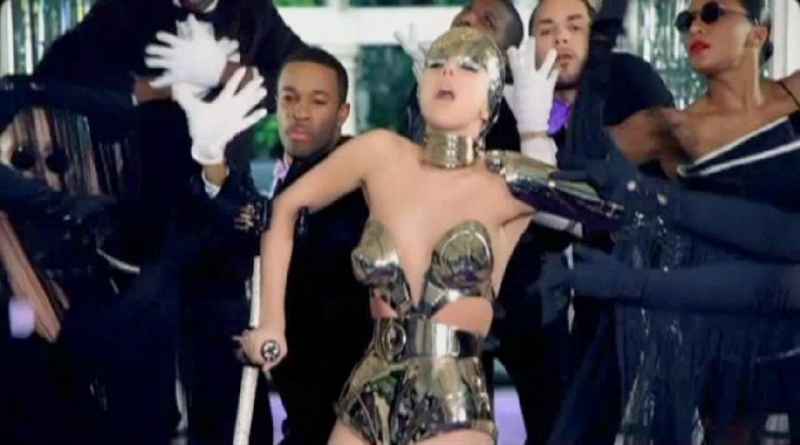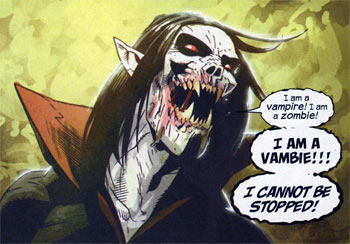 |
| Images from Lady Gaga's video for her song "Paparazzi" |
The camera focuses in on an intimate scene between Gaga and her boyfriend kissing (the boyfriend is played by True Blood Star, Alexander Skarsgård) at a very opulent and glitzy mansion. There are some lines spoken to each other (can’t determine language but there are captions), and they move out together to a balcony. They are photographed by paparazzi, and for whatever reason, the boyfriend then throws Gaga off the balcony.
There is about 10-15 seconds of Gaga falling with a swirling mesmerizing graphic in the background, almost dreamlike, and then you see cameras taking pictures of her on the ground, broken, damaged, and almost dead. You discover that she is not dead only because the newspaper headlines scream that Lady Gaga is done and over (BUT NOT DEAD).
Because she is disabled she is no longer popular. But this is definitely a temporary disability. She overcomes her disability, and I can’t tell if she does this to become famous again, to win back her boyfriend, or to get revenge on her boyfriend or all of the above, but I see this as she has to become able-bodied again to be successful (not just gaining fame, but exacting revenge). There are several scenes of dead women (at least they appear to be dead), and I can only speculate whether they were killed by the boyfriend or if was “fame” that killed them (death is the ultimate disability, isn’t it?).
An odd fact that I can’t explain is that the boyfriend, at the end, has a disability as well. He is wearing a metal eye patch, and I can’t think of any particular REASON why he would have an eye patch (some have said that she smacks the boyfriend as he's throwing her off the balcony, but I'm not 100% sure of this). An accessory? More glamorizing disability, except this time it’s masculine disability? Is this supposed to make him more sympathetic? Gender of course plays into this, as there is such a difference between some disabilities for men versus women. An eye patch on a man is more suave and debonair and the affect of the disability can be almost nulled (how many spy or action movies have there been that glean over these kinds of minor disabilities?). If you see an eye patch on a woman, it is fetishized, more disabling and more “freaky.”
There is about 10-15 seconds of Gaga falling with a swirling mesmerizing graphic in the background, almost dreamlike, and then you see cameras taking pictures of her on the ground, broken, damaged, and almost dead. You discover that she is not dead only because the newspaper headlines scream that Lady Gaga is done and over (BUT NOT DEAD).
Because she is disabled she is no longer popular. But this is definitely a temporary disability. She overcomes her disability, and I can’t tell if she does this to become famous again, to win back her boyfriend, or to get revenge on her boyfriend or all of the above, but I see this as she has to become able-bodied again to be successful (not just gaining fame, but exacting revenge). There are several scenes of dead women (at least they appear to be dead), and I can only speculate whether they were killed by the boyfriend or if was “fame” that killed them (death is the ultimate disability, isn’t it?).
An odd fact that I can’t explain is that the boyfriend, at the end, has a disability as well. He is wearing a metal eye patch, and I can’t think of any particular REASON why he would have an eye patch (some have said that she smacks the boyfriend as he's throwing her off the balcony, but I'm not 100% sure of this). An accessory? More glamorizing disability, except this time it’s masculine disability? Is this supposed to make him more sympathetic? Gender of course plays into this, as there is such a difference between some disabilities for men versus women. An eye patch on a man is more suave and debonair and the affect of the disability can be almost nulled (how many spy or action movies have there been that glean over these kinds of minor disabilities?). If you see an eye patch on a woman, it is fetishized, more disabling and more “freaky.”
To examine how disability is portrayed in this video, one just has to look at whether or not she tries make disability chic, temporary or not. Is she normalizing disability, temporary or not? Her wheelchair while it is difficult to get a glimpse it, is I believe jewel encrusted (she did have a design for it that was ultimately scrapped). She has a very glamorous neck brace and her costume as she uses her crutches is reminiscent of a famous robot (shades of “Metropolis”), but while she staggers, the crutches seem to be mere props, a temporary condition.
From Lady Gaga’s bio on her website, she writes (excuse the all caps):
“ON FIRST LISTEN, “PAPARAZZI” MIGHT COME OFF AS A LOVE SONG TO CAMERAS, AND IN ALL HONESTLY, GAGA JOKES “ON ONE LEVEL IT IS ABOUT WOOING THE PAPARAZZI AND WANTING FAME. BUT, IT’S NOT TO BE TAKEN COMPLETELY SERIOUSLY. IT’S ABOUT EVERYONE’S OBSESSION WITH THAT IDEA. BUT, IT’S ALSO ABOUT WANTING A GUY TO LOVE YOU AND THE STRUGGLE OF WHETHER YOU CAN HAVE SUCCESS OR LOVE OR BOTH.”” (copied from http://www.ladygaga.com/default.aspx).
Other sources have Princess Diana as the inspiration for the video itself.
The parts of this video that deal with disabilities makes me think of some of what Rosemarie Garland-Thomson talks about—there is more than one way to be a woman (2004, p. 88), but also that although (p. 77) "the informing premise of feminist disability theory is that disability, like femaleness, is not a natural state of corporeal inferiority, inadequacy, excess or a stroke of misfortune. Rather, disability is a culturally fabricated narrative of the body, similar to what we understand as the fictions of race and gender.”
I think Gaga actually does the opposite. She does acquire her disability as a misfortune. She does NOT normalize her (temporarily) disabled body, in fact in mere seconds she is able bodied again. It is also contrary to Wendell’s idea of pace of life (Wendell, 1996). It is rather in fact the pace and demands of fame that disables people, some literally, some figuratively.
Intrusiveness of paparazzi. Self-esteem. Freakishness. Gaga in and of herself is a modern-day, western oriented parody of wealth and success, but in her artistic expression, doesn’t she create another modern-day freak show? Her creativity was born from being rejected by three important men in her life (her father, her ex boyfriend, and the rapper who didn’t give her a chance). At first, her music was “alternative”; but once she established herself, then she says she was able to be “creative.” (this is based on an interview in Rolling Stone). She has faced disability in her personal life, her aunt who had lupus died from the condition, and she herself has tested for the possibility of acquiring the disability, but she doesn’t factor that into the video or song that I could see, as lupus is in itself a fatal disease (it can literally kill you, not like other conditions which are more gradual).
But is she prostituting herself? Is she trying to say that being female and famous can disable you in other less obvious ways? And there’s one lyric that’s interesting: “We’re plastic but we’ll still have fun.” She seems to be a white, upper class “freak” (apparently she uses this word a lot). It might take more time to analyze Lady Gaga’s purpose in using disability in this way. There are sources out there that analyze this video and its portrayal of disability, but I wonder if she is normalizing disability or fetishizing it or maybe just plain questioning what normalcy is supposed to be. Certainly we all know that violence can create disability, especially gender specific violence (abuse), but then again we could spend a lot more time on analyzing all the different aspects of this video.
Watch. Think. Discuss.
Resources and Links:
- Garland-Thomson, R. (2004). Integrating Disability, Transforming Feminist Theory. In B. G. Smith & B. Hutchison (Eds.), Gendering disability (pp. 73-103). Piscataway, NJ: Rutgers University Press.
- Wendell, S. (1996). The social construction of disability. In S. Wendell, The rejected body: Feminist philosophical reflections on disability (pp. 35-56). New York: Routledge.
- Lady Gaga: Princess Diana was Inspiration for Paparazzi video. (2009, September 2). Showbizspy.com Retrieved February 9, 2011 from http://www.showbizspy.com/article/191297/lady-gaga-princess-diana-inspired-paparazzi-video.html. (inspiration for the video was Lady Diana).
- Lady Gaga, The Illuminati Puppet. (2009, August 4). The Vigilant Citizen. Retrieved February 9, 2011 from http://vigilantcitizen.com/?p=1676. (Interesting analysis of symbolism and Gaga)
- The Transcontinental Disability Choir: Disability Chic? (Temporary) Disability in Lady Gaga's "Paparazzi.” (2009, November 20). Retrieved January 20, 2011 from http://bitchmagazine.org/post/the-transcontinental-disability-choir-disabililty-chic-temporary-disability-in-lady-gagas-papar.
- Bauer, N. (2010, June 20). Lady Power [Opinionator Blogs]. New York Times. Retrieved February 8, 2011 from http://opinionator.blogs.nytimes.com/2010/06/20/lady-power/?hp.
- Lady Gaga – Paparazzi [Video]. Retrieved February 8, 2011 from http://www.youtube.com/watch?v=d2smz_1L2_0.
- Lyrics to Lady Gaga’s “Paparazzi”--http://www.metrolyrics.com/paparazzi-lyrics-lady-gaga.html
- Lady Gaga’s disability project. (2010, January 22). Sociological Images [website]. Retrieved January 20, 2011 from http://thesocietypages.org/socimages/2010/01/22/lady-gagas-disability-project/.
- Questions About The High Fashion & Domestic Violence In Lady GaGa’s Video--http://jezebel.com/#!5285868/questions-about-the-high-fashion--domestic-violence-in-lady-gagas-video













